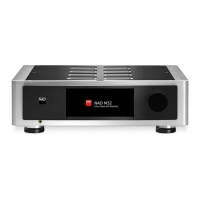DISPLAY MENU OPTIONS
The following display options are accessible via the touch panel display -
Main, Media, Mode, EQ and Setup.
MAIN
Use the Main screen to select a Source. Use the arrows to navigate to the
required Source. In the following example the Main screen is displaying the
Coax 1 information.
Coax 1: Current Source.
-20.0 dB: Volume level.
: Go to previous or next Source.
48k: Sample rate.
Mono: Listening mode.
Negative: Polarity setting.
Tone: Tone control settings enabled.
Balance: Balance settings enabled.
Sub Stereo: Subwoofer mode setting.
LPF 200Hz, HPF 200Hz: Subwoofer frequency setting.
MEDIA
During BluOS playback, display switches to Media and show current song
title, artist name and album name if available.
MODE
The following listening modes, tailored for dierent types of recording or
program material, are provided.
STEREO
• Select “Stereo” when you wish to listen to a stereo production, such as
music CD or FM broadcast.
• Stereo recordings whether in PCM/digital or analog form and whether
surround-encoded or not encoded, are reproduced as recorded.
• Multi-channel digital recordings (Dolby Digital and DTS) are reproduced
in “Stereo Downmix” mode via the left and right speakers only.
MONO
• Use “Mono” listening mode when the audio source format is mono. The
mono information is replicated on both left and right channels.
• “Mono” listening mode is recommended when watching old movies
with mono soundtrack, listening to recorded monaural sound sources
such as AM radio broadcasts or with the foreign language soundtracks
recorded in the left and right channels of some movies.
• Mono is also very helpful when setting up a stereo system to check that
both speakers are connected with correct polarity. Correctly connected
speakers will have a solid center image and strong bass response. If one
speaker has the input connections (+ and -) reversed, the image will be
indistinct and the bass will be reduced and uneven sounding.
REVERSED
• Sends the right channel to the left speaker and the left channel to the
right speaker. This can easily correct a reversed input connection or
incorrectly recorded music source.
POLARITY
This setting provides compensation for recordings that have reversed
polarity.
• Positive: A positive sine wave at the input remains positive at the
output. Polarity is defaulted to “Positive” setting.
• Negative: A positive sine wave at the input is negative (inverted) or
reversed at the output.
OPERATION
USING THE M32
12

